
BGR Foodservice Sdn Bhd is a food & beverage operation company for Bangi Golf Resort's which is located in Malaysia. They are using PAL-BX/SALT+5 to manage ther food such as jam. PAL-BX/SALT+5 can measure Brix and salt concentration in one device, so it is quite suitable for managing food.
Koji is the Buffet style restaurant which is for all ages and serves Japanese food. They are using PAL-pH to manage the seasoning such as Miso and soy sauce. PAL-pH is user friendly because it requires just few drops to measure.
Kin No Buta is a Ramen shop which is located in Nueva Ecija, Philippines. The are using ATAGO`s Hybrid brix and salt meter PAL-BX|SALT to maintain brix and saltiness of the ramen soup they make. Kin No Buta watched a famous ramen youtuber "Shimayan" video which we did a collaboration with.
Maritim Food AS is a company which manufactures processed seafood and dressing in Norway. They are using PAL-pH to control and maintain the pH of the food they manufacture. What Maritim Food AS loves about the PAL-pH is that it is very easy to use. PAL-pH only requires 0.6mL of sample and is more durable than other pH meters.
Pak Man Industries is a company who manufactures halal certified food paste. They are using PAL-BX|SALT to measure brix and salt level of their food paste. PAL-BX|SALT measure both brix and salt level in just one device, and gives you tips for the best balance of brix and salt level.
URC is a snack company in Thailand. Several models from ATAGO's MASTER series are used for their qualit control of sucrose solutions. With hand-held refractometer, they provide high quality, tasty snacks to their customes.
Oma Makia is a chocolate maker who makes uniquely hand-painted, shiny chocolates in Finland. They uses PAL-Pâtissier refractometer for achieving better taste. PAL-Pâtissier show brix% and sugar baume, and helps Oma Makia oy to manage the taste of their sweets.
PT. Misaja Mitra is one of the leading shrimp processing company in Indonesia located in Pati, Central Java. They specialize in producing shrimp for raw frozen, breaded and fry products. DOM-24 is used to check the quality of the frying oil.
All Field is a ecudaorian company that manufactures preminum quality banana platain and cassava snacks which are gluten free and kosher. All Field is using ATAGO`s oil frying monitor DOM-24 to measure the AV and TPM of the frying oil that is used to make chips.
B-Carry is a Japanese company that makes tofu in Vietnam.
The PAL-27S is currently used to measure soy milk during production to ensure stable tofu taste.
The NFC feature is used to get measurement data from the device to a smartphone.
Toiteevit Garden is a handmade jam and marmalade manufacturer in Thailand. In the process of making fresh fruits based products, MASTER-80H is used for measurement of sweetness. MASTER-80H measures jam and marmalade accurately from 60-70% brix.
RX-5000α
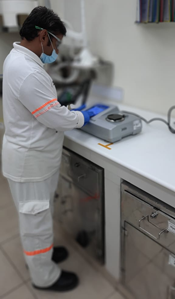
Nestle Pakistan is the largest manufacturer of dairy products and juices in Pakistan.
They have two plants that are using ATAGO products, Nestle Sheikhupura Plant and Nestle Kabirwala Plant.
Below are details from their user at Nestle Kabirwala Plant.
QHow long have you been using this product?
AMore than 6 years.
QWhat samples you are testing in refractometer?
AChecked refractive index of butter, fats and oils, Brix and total solids in milk products.
QBefore this instrument how did you test your samples?
AWe measure the brix and total solid by using our internal reference method approved by Nestle(oven method) and for this minimum 6 hrs. were required. Since then we have shifted to ATAGO Refractometer.
QYour feedback for instrument performance?
AWe are fully satisfied with performance of Atago Refractometer.
The instrument requires no service, is very easy to use and it gives most accurate and reliable results.
Our product is released on the basis of its results.
Shangrila Foods Private Limited manufactures various sauces and seasonings.
With the RX-9000i benchtop refractometer`s useful pre-programmed user scales, they can easily change between Brix%, NaCl %, and NaOh% measurements. RX-9000i was chosen for it`s wide measurement range and high accuracy to measure even slight differences in their products for high precision in test results and helps control product quality.
RX-5000i

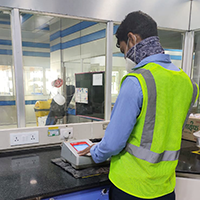
QWhat is your feedback on our model which you are using?
AWe can check so many scales like RI, Butyro and Iodine Value on our Rx-7000i, This is really a great deal for us. Edible Oils like Sunflower, Rice bran, Soya etc all can be checked using different scales at 40 deg or even at room temperature. Once we create the scale for Iodine Value, this can be used to check. This saves us a lot of time.
QAre you satisfied with our after sales support?
AConsistently giving us good service, no room to complain.
RX-5000i
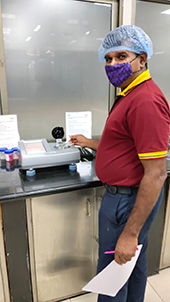
QWhat is your feedback on our model which you are using?
AWe are using Atago RX-5000i model for our fruit & vegetable pulp application, to check Brix, and we are very much reliant on this model for all our quality needs. Mother Dairy also uses Rx-5000i to check the Ghee (saturated fact) Butyro value and Refractive Index at other plants.
QAre you satisfied with our after sales support?
AAlways eager to help us in time of need.
RX-5000i
QWhat is your feedback on our model which you are using?
AKetchups can be a tricky sample. The viscosity affects the Brix readings. We needed a sureshot value of Brix across batches. The repeatability of the results is what we depend on. Rx-5000i fully ensures that results are bankable batch after batch.
QAre you satisfied with our after sales support?
ANo problem with them, we are very happy with the performance and with after sales service.
PAL-SALT
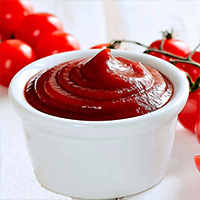

QWhat is your feedback on our model which you are using?
ASaved us a lot of money from the costlier alternative of Silver Nitrate. It works just as fine and we can depend on these results for our audit too.
PAL Salt is really handy and now we can even transfer data using NFC.
The offset feature is also very useful for us.
QAre you satisfied with our after sales support?
AYes, in case of any query, ATAGO INDIA Delhi team is always eager to resolve our issue from time to time. We are in fact using ATAGO models at multiple locations.
C&F Enterprise is a manufacturer of snack foods in Sabah, Malaysia.
For their snack foods, quality management is important for stable taste.
They are using the PAL-2 to monitor the quality of sugar syrup from 70-76% Brix.
Scelta Umami BV is a food production company and has been in the mushroom industry for 25 years. They make a wide variety of mushroom and vegetable appetizers.
They are measuring mushroom concentrates/powders with the PAL-a, which has a wide range of brix 0.0 - 85.0%.
With PAL-a it is possible to measure a lot of samples, as well as samples that are in the cooking process.
JM Smucker is a American leading consumer package goods company since 1897 which manufactures jam, jelly, peanut butter and other food products.
JM Smucker is using PR-301a which measures high concentration samples to test the brix of their jam and jelly products.
Cristalita S.A. de C.V. is a company that sells a large variety of processed strawberry products and use the MASTER-93H to measure fruit jams around 65.0% Brix.
MASTER-93H is the traditional analog type of refractometer with high heat resistance.
Arborea is an Italian Dairy Company producing dairy products such as milk, yogurt, cream, and cheese from Scandinavian milk.
Arborea S.C.A.P.A. is a long time user of the PR-201a palette style refracometer for controlling the finished product for packaging as well as for Research and Development.
Puratos Chile SpA. offers various ingredients that are essential for the bakery, pastry and chocolate industries.
PAL-3 is used to measure the Brix% of glucose accurately from 81-85% Brix.
Portable PAL-3 enables producers to check the quality whenever they want, and measurement history is available anytime via NFC data output.
PAL-3's high accuracy and its efficiency contribute to the stability of taste.
Sawadaya Co., Ltd.'s "Kurotama" is a famous confectionery in Yamanashi prefecture where anko balls made from high-quality peas that are wrapped in fragrant brown sugar yokan.
In addition, the jelly "Invitation Confectionery" made from the fruit of Yamanashi is also gaining popularity as a summer staple. (4 types of peach, grape, plum, and ome)
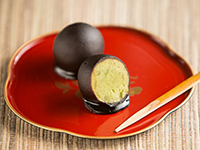
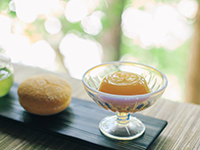
Sawadaya has already been using ATAGO's handheld refractometer for the control of boiling and sugar content during the process of making anko, but this time ATAGO`s PAL-pH was introduced for jelly. In order to produce jelly with the ideal texture, pH control in the manufacturing process is indispensable.
A dip style pH meter by another manufacturer was previously used. After looking at the PAL-pH on ATAGO's website, the deciding factor was that there was no need to insert electrodes into the product. Since we are handling food, it is hazardous to break glass, so we have also evaluated the durable electrode of PAL-pH.
Please enjoy the traditional sweets of Sawadaya, who have been around since 1884. You can also see the new product information of Sawadaya Co., Ltd. on the following social media sites.
Instagram: https://www.instagram.com/sawataya/
Twitter: https://twitter.com/SAWATAYA_PR
Located in Sapporo and Tomakomai, Anne Charlotte Co., Ltd., applies their concept of "expressing basic and honest deliciousness" to their delectable sweets and decorated cakes.
A bread made with ingredients and recipes unique to confectionery shops, also called "Luxury Bread Made by Pâtissiers " (Tomakomai store only), has also become popular in recent years.
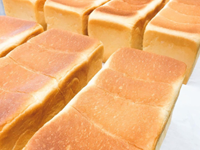

As for ingredients, Hokkaido wheat, butter, and whey (instead of water) is used.PAL-pH is used for the pH control of the whey.
While looking online for a pH meter, they came across the PAL-pH and in light of ATAGO`s brand strength and creditworthiness, purchased the unit.
Please enjoy Anne Charlotte`s inexplicably delicious and honest sweets that are made with the highest quality ingredients.
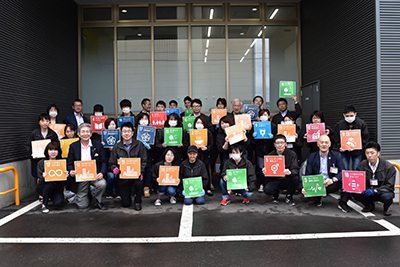
IBICS Foods Co. Ltd is a manufacturer of various soups, stocks, and sauces, focusing on ramen sauce concentrate. Specializing in original seasonings made from local Hokkaido ingredients, IBIC Foods handles a wide range of products for both commercial and home use, and even develops recipes using its products.
Before, a benchtop pH meter was used for quality control. The PAL-pH was introduced for easy checks on the production floor since it can be held with one hand and obtains the value within a few seconds.
Since the PAL-pH`s electrode is tempered glass (withstands a load of up to 5 kg), it is hard to break. This reduces the risk of contamination and is safe to use even on the production floor.
Mr. Nicolas is a famous pastry chef and chocolatier with over 20 years of experience.
Between 2012 and 2016, he taught as a pastry chef at Ecole Valrhona Tokyo.
Since that time, he has been a customer of Atago's PAL™-Patissier.
He is traveling and teaching in 15 countries around the world and has now an online school to share his knowledge, techniques and recipes.
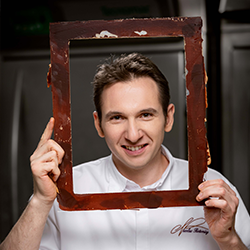
QWhat are you measuring with PAL™-Patissier?
AI use Atago products in a variety of creations such as sorbets, pâte de fruit, glazes, syrups, ice creams, jams, caramels and ganaches,and I find the measurements useful for adjusting the flavors because the natural ingredients are different every times.
QCould you tell me why do you choose to use Atago products?
AI like Atago for the quality of built, the hand calibration and the fact it is made in Japan. The range of product is really wide and they have a product for every purpose, I use Atago products for almost ten years and it has always been reliable and helped me to ensure good consistency in my different productions all arround the world.
QDo you use other products?
AYes, I use PAL™-S, PAL™-pH, etc.


PAL-Pattissier and PAL-pH are also available as Nicolas' exclusive models.
You can also join Nicolas' wonderful lessons at this link.
Ishii Food Co., Ltd. is a food processing manufacturer with a history of 75 years, headquartered in Funabashi City, Chiba Prefecture. Currently, it is manufactured at three locations nationwide: the Yachiyo factory, the Karatsu factory, and the Kyotamba factory.
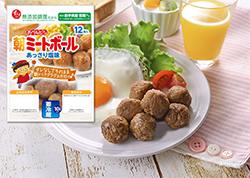
Popular meatballs
With the corporate philosophy of "Earth-friendly, integrating deliciousness and safety, and devoting all our efforts to customer satisfaction," in addition to safety, security, and deliciousness, we are particular about additive-free cooking that makes the best use of the ingredients.
In order to protect the "Taste of Ishii", it is well managed using objective parameters, and the refractometer PAL™-J is used to manage the important "seasoning" that determines the taste of the product.
PAL™-J allows anyone to easily measure seasonings in just 3 seconds without any preparation. After the measurement, even highly viscous seasonings can be easily washed, so it is very useful in the field.

Measuring viscosity with VISCO™ changed viscosity management from sensory to a numerical value and made the viscosity of soup more consistent and stabilized the mouth feel.
VISCO™ is lightweight, compact and easy to carry, so it can be carried to the manufacturing site for quick measurement. Because it is easy to operate and does not require any special skill, it enables smooth manufacturing.
RX-5000i, PAL-3 and DR-A1
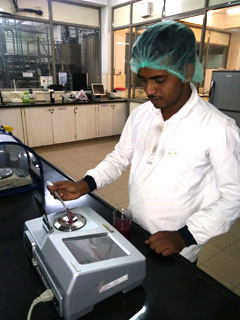
QWhat is your feedback on our model which you are using?
AWe really appreciate the versatility in the products of ATAGO. For our syrups, we use DR-A1, for our pulps we use Rx-5000i and for quick testing at floor level we use PAL-3. ATAGO has been a trusted partner for us.
Pomegrante pulp, mango pulp and guava pulp are our main products. Different modes in Rx help us determine the accurate Brix which is crucial for our exporting needs.
QAre you satisfied with our after sales support?
AThey are always ready to help for our technical needs and support our staff whenever we ask for help. Sometimes, when the chemists change, and new ones need to be trained; we can bank on ATAGO INDIA.
RX-5000i
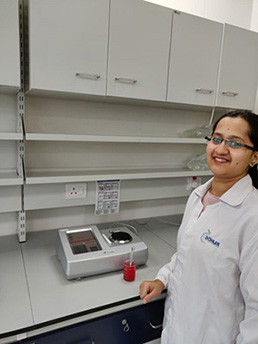
QWhat is your feedback on our model which you are using?
AWe use this model for our Food Application lab in R&D and sampling division. We are using 2 RX-5000i which offers high accuracy and quick results at desired temperature. Our samples are flavours and food additives.
In our R&D applications, we sometimes are not able to know what the RI of the product is. That’s why we need a reliable refractometer which we can use for discovery of RI. RX-5000i provides just that. We upgraded from RX-5000 to RX-5000i.
QAre you satisfied with our after sales support?
AWe are getting prompt service for our calibration calls and AMC too.

All started in 1919 when Isaac Carasso is the first Danone yogurt with fruit pulp in Barcelona. In Barcelona, Spain? Yes, the first yogurt with fruit pulp was made in Spain, and only in 1929 is founded Danone in France. However, the group went international in fact with the merger of BSN with Gervais Danone in 1973, which brought together two ambitious companies, creating a powerful drive that was destined for success. Danone arrived in Brazil in 1970, through a partnership with Dairy Pocos de Caldas. Already innovative at the time, launched here a new and very tasty product: yogurt with fruit pulp.
Use of the RX-5000i equipment ATAGO is essential for the quality control of our products; it is possible to monitor the correct degree of Brix for the production of the best yogurt in the world happen.

RX-5000i
We like the big screen, big sample chamber which is easier for operator to fill oil and do cleanup. Precision and repeatability is excellent as well! Robust, user friendly design. (Food Chemist)

We have been using DOM-24 for our quality control audits in our plants.In regards to the instrument, below are my comments:
It is a unit that offers several advantages and has been very useful throughout the data analysis that we need. We definitely recommend it.
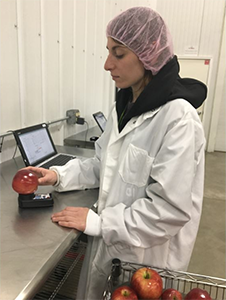
By using the PAL-HIKARi5 nondestructive brix tester for our apple sampling program we have decreased the time it takes for brix sampling by 75%.
The nondestructive tester helped with improving the efficiency of our sampling program. Now we can simply place the PAL-HIKARi5 on the uncut apple and in 5 seconds we have the brix for the apple. No more sticky, juicy messes and destroyed apples. By using this tester we have doubled the amount of apples we are testing while lowering the amount of time we spend on testing.
Ezaki Glico measures the viscosity of yogurt and pudding. They purchased the VISCO™ (Package B) for its portability, which makes it possible to use in the factory. The VISCO™ received high praise at Eizaki Glico for its compact and stylish design with accurate and stable measurements.
At Foremost Blue Seal Ltd. the VISCO™ is used to manage the viscosity of their ice cream mix. For ice cream, the way it melts in your mouth is directly related to how good it tastes. The VISCO™ is mainly used during product development and it prevents equipment failure during the filling process. The VISCO™ was highly evaluated because only a small amount of test sample is required for testing and virtually anyone, even first-time users, can easily operate the VISCO™.
Tsuru Miso Jyouzou Co., Ltd. was founded during the Meiji period (1871) and is located in Yanagawa City of the Fukuoka Prefecture. Having a history of over 140 years, their motto is to follow tradition, and keep up the same formula and taste. They also make ‘miso’ (paste made from fermented soybeans) used in miso dispensers for the restaurant industry. If the amount of ’miso’ dispensed is not consistent, the flavor changes. One of the key factors in measuring a consistent amount is viscosity. In addition, if the ’miso’ is too thick, it can clog the dispenser. For this reason maintaining the viscosity of the ’miso’ is also important. Tsuru Miso Jyouzou Co., Ltd. is fond of the fact that the VISCO™ is very easy to use on their production floor. The VISCO™ only requires a small amount of test sample in order to get a measurement. Tsuru Miso Jyouzou Co., Ltd. was happy that their miso would not go to waste.
Muginoho Co., Ltd. operates a franchise of cream puff specialty stores called “Beard Papa’s Fresh and Natural Cream Puffs.” In order to keep the cream puffs at a consistent firmness, the viscosity of the dough is measured. In the pursuit of the perfect crunchiness at first bite, and the smooth, creamy, taste, Beard Papa’s is very particular about their ingredients and preparation methods. To deliver the same fresh, light, creamy, and flaky consistency every time Beard Papa’s chose the VISCO™ for its onsite “portability” and “ease of operation” for anyone.
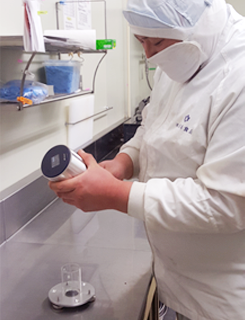
Getting the VISCO™ ready for use
Katori Foods has been producing specialty handmade quality frozen foods for over thirty years. All food is handmade so Katori Foods is consequently able to customize their products based on the customer’s tastes, size or ingredient ratio and other detailed requests, tailoring to small order lots. Katori Foods uses these strengths to manufacture food that does not seem like frozen food, but that of a home cooked meal, similar to ready made foods found at the store, are Katori Foods major product.
Katori Foods focuses on monitoring the frying batter when making fried foods such as ‘rolled katsu’ (fried pork rolls) or ‘tatsuta age’ (fried chicken) and so on. If the batter is too thick, the breading will be too thick when fried, leading to customer complaints. If the batter is too runny, the beading will not adequately cover the food resulting in lack of flavor. When deep frying food, monitoring the viscosity of the frying batter liquid is one of the most important control points.
In order to monitor the viscosity of liquid batter, normally a viscometer would be needed. Below are the reasons why a normal viscometer would not work.
ATAGO's VISCO™ solve dall aforementioned problems.
When measuring the viscosity of the batter, it needs to be measured quickly, and near the production site, as difference in temperature can affect measurement results. Traditional viscometers were too large and could not be used in the production area, but ATAGO's handy sized VISCO™ is compact and can be used on the production site. The VISCO™ also can be battery operated so it can be used virtually anywhere.
Easy operation of the VISCO™ was one of the reasons for choosing VISCO™. To operate the VISCO™, only one button is needed so there is no confusion when taking measurements. There are people of many different ages and genders that work on the production floor. Also depending on the shift, not always the same person will be taking measurements. An instrument that anyone can easily take measurements, was a prerequisite for implementing the VISCO™.
Speaking with Katori Foods, what stood out was how much importance they place on “fostering workforce education.” Katori Foods particularly focuses on “handmade” food; as the name suggests, food is made by “a human being”. Food made by a person’s hand is then eaten by consumers. That is especially why Katori Foods strongly believes in improving quality and consistency with the ultimate result being improved sanitation management and quality control. Also by adding a numerical values to what was once only determined by the senses, is a short cut to workforce education and the VISCO™ is of great use in achieving this. Consistency in quality control is not the only achievement brought by VISCO™. Building an environment where anyone can work is where the VISCO™ truly succeeded.
Thank you for taking the time to speak with me and sharing such valuable information. (Katori Foods also take small lot orders by customer request and can customize foods depending on the tastes of individual customers.)
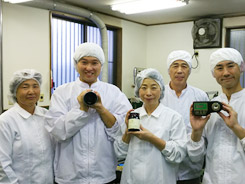
At Joint Enterprise Cooperative Worker’s Collective
Joint Enterprise Cooperative Worker’s Collective Bon manufactures jam and syrup using all natural ingredients.
Without using chemical seasoning, artificial colors, artificial flavoring or preservatives, Joint Enterprise Cooperative Worker’s Collective Bon, offers products utilizing seasonal local produce and fruits, bringing the best out of the ingredients.
As part of the quality control procedures, at Joint Enterprise Cooperative Worker’s Collective Bon, ATAGO’s viscosity meter and Brix meters are used. Both the viscosity and Brix meters are used during inspections before filling the bottles.
Mr. Kobayashi who is in charge of manufacturing mentioned as follows:
QHow useful is the VISCO™ ?
AVISCO™ is used to test the viscosity of our blueberry sauce. Originally, we were not using a viscosity meter but we decided to implement in order to make higher quality products. The blueberry sauce is generally used as a spread on bread or as a sauce for yogurt. Maintaining the right texture and viscosity was just as important as the flavor.
Compared to a B type viscosity meter, the VISCO™ is low cost and simple to operate, that anyone can easily use the VISCO™ at the production site. By using the VISCO™, we are able to screen and catch defective sauces that are too low in viscosity prior to shipment.
QHow user friendly is digital Brix Meter PR-201α?
AThe use of the PR-201α is as simple as placing the test sample on the prism and pressing a button. It is convenient and easy to operate. Even with highly dense and viscous samples like jams or fruits sauces PR-201α provides steady measurements. The condition of products can be checked by using the human senses but by actually taking measurements and providing numerical backing, it can prove the products’ viability and reassures the manufacture.
Thank you for taking the time out of your busy schedule to speak with us today Mr. Kobayashi.
Products from Joint Enterprise Cooperative Worker’s Collective Bon are available for purchase online.
If interested, please see their website.
We thank you for your continuing patronage.
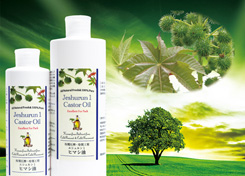
Kushiro Pharmacy Inc. offers a wide variety of products; from supplements to castor oil, olive oil and peanut oil. Kushiro Pharmacy Inc. supports and promotes naturopathy (naturopathic medicine), such as the "Edgar Cayce Therapeutic Regimens."
Additionally, Kushiro Pharmacy Inc. manufactures cosmetics, and also provides American herbs, supplements, and other products used in special therapeutic treatments, such as salt and Epsom salt.
Kushiro Pharmacy Inc. also manufactures and sells honey. They have an extensive line-up of different types of honey: white clover, cinnamon, honey with pomegranate extract, sacred fig, buckwheat, lotus, and honey containing royal jelly and propolis (aka bee glue--a resinous mixture that honey bees collect from tree buds, sap flows, or other botanical sources).
Our business partner (a fragrance and flavoring manufacturer) requested that we measure angle of rotation. We searched on the Internet and came across ATAGO’s RePo-1. We selected the RePo-1 based on its affordable price and its ability to measure both Brix and angle of rotation.
QHow are you using the RePo-1 ?
AIn addition to measuring the angle of rotation of fragrances and flavorings, as previously mentioned, we also use the RePo-1 for examining the honey in the manufacturing process. If honey contains too much glucose, it may solidify. If honey contains too much sucrose, it may be thin and watery. For this reason, we examine the ratio of glucose and sucrose contained in honey.
QWhat do you think about the RePo-1's usability ?
AIt is lightweight and easy to carry, which makes it tremendously convenient. Also, it is possible to get both the angle of rotation and Brix by switching scales with the press of a single button, which allows for efficient measuring.
Ultimately, we conduct sensory evaluations* based on the measurement values obtained with the RePo-1 in order to ensure we continue to provide our customers with universally safe and reliable products.
※sensory evaluation: an inspection method based on the senses (sight, hearing, touch, taste and smell) used for judging the quality of a product.
We appreciate your continued support of ATAGO refractometers.

Bussan Food Materials Co., Ltd., is a company that manufactures and distributes processed fruits, juices, and syrups.
Their products are used for production of juices, ice creams, jellies, yogurt, candies, dressings, and sauces. These products are shipped out according to vendors' needs.
During their manufacturing process they use our hand-held refractometers and the RX-5000α Digital Refractometer for quality control.
Their office location is about a 5 minute-walk from the JR Asakusabashi station or Bakurocho station, and Toei Line Asakusabashi Station.
They moved to this nice new office location in August 2010.
Our staff visited the technological development center located on the first floor.
QWould you tell us about your line of business?
AAt our technological development center, we strive to support production of high-quality products by using our longstanding technology towards product development, material receiving inspection, and product inspection.
Once you enter, you will see that many of their labs are walled with large windows.
Their technological development center was based on the concept of "Transparent Laboratory," and from the hallway employees and guests are able to observe the work being done in the laboratory.
They carry three each of the same instruments, and they are strategically situated so that measurements can be taken in sequence three at a time. Our RX-5000α is also placed in three stations.
QWhat are the inspection components for quality control?
AThey include, but are not limited to, Brix (sugar content), acidity, pH, color, sensory evaluation, foreign materials inspection, and bacteriological testing.
QWhat do you emphasize during quality control?
AWe strive to maintain fast and reliable service to provide our customers with safe and unfailing products. We set high operation standards and check our inspection apparatus so that we can always maintain exceptional precision.
Also, we work to improve our product quality by regularly training employees for sensory evaluation.
QHow do you inspect and calibrate our refractometers?
ABefore each usage we calibrate the refractometers with distilled water, and we also do a monthly calibration with 40% and 60% standard sucrose solutions to confirm on its accuracy. On top of that, we send our units to a 3rd party lab for annual calibration. Also, to increase the consistency of measurements taken at this lab and the labs at other production facilities, we use the same RX-5000 series to measure the same samples.
QHow user-friendly is the RX-5000α?
AI have always been using ATAGO's refractometers since I started working here. The first model that I used was an Abbe refractometer. Depending on the color of fruit juice, sometimes I had difficulties reading the scale due to it being too dark, but improvement was made quickly. From the original Palette type, it was improved into more accurate RX-5000, and now we use the RX-5000α. The RX-5000α is easy to use, and I feel it is what an ideal Brix measuring devise would be.
Thank you very much!
At the QC lab, we collect fruit juice with a spatula and place it on the sample stage of the RX-5000α, taking measurements one after another.
Though the samples are all fruit juices, there are some that are murky while others are clear with no pulp. Also, there are many different types of clear juices, such as those with darker tint and those that are completely transparent.
Translucent juices are used to clear-coat products, such as candies.
We had an opportunity to taste some of the juices.
It was hard to judge the slight differences in flavors. Also, for sour juices, its taste was too strong for me to judge flavors by a taste test.
Tasting their juice samples reminded me of flavors of all the different candies and snacks that I have had, and made me realize how widely their products are used.
QPlease tell us about the manufacturing process of your factory's juice products.
AThere are many steps to our manufacturing process, such as material receiving, defrosting, blending, sterilization, UF filtration, concentration, packaging; I will give you an overview of these processes.
First we must carry in the raw materials. We procure raw materials in its best condition; to maintain its quality, we manage the temperature conditions to be appropriate for each product. After preparation, products are boiled down or go through Ultrafiltration (UF).
During the heat concentration stage, we use the N-2E, N-3E Hand-held Refractometers to frequently check its Brix values. In order to preserve the natural taste of fruits, heating is performed swiftly.
Upon requests from customers, some of our products go through Ultrafiltration (UF). This process removes any insoluble solids that cause turbidity or sedimentation through membrane filtration. The size of the filter is a molecular weight cut-off (MWCO) of 6,000, which filters out most insoluble solids, producing high-quality clear juice concentrates.
Processed juices go in tanks, and every single tank is tested for quality. Only those that meet our QC standard can go on to the next stage, sterilization.
For sterilization, we use plate-type for juices and kneader-type and tubular-type for pulps.
Next is the packaging process. Here, the processed goods are filled into cans, sacks, or boxes to be shipped. Different types of packaging are used according to our customers' needs. We store products at the most appropriate temperature for each product, but most are stored frozen to preserve the flavor.
QDoing business with fruits must be hard since it's affected so much by weather.
AWhen we are obtaining raw materials, we always take into consideration the weather patterns and harvest seasons of the northern and southern hemispheres. We import from all over the world, and we perform inspections at production sites to maintain quality of all the ingredients.
QPlease tell us what makes your company special.
AOur company motto is "Everything Processed Fruits," and we pride ourselves in the wide variety fruits and processing methods we make available.
From small batches to unique orders, we can always tailor our products according to customers' needs.
We are working on perfecting our fit-to-need services from development to shipment to thoroughly support our customers.
Mr. Hosono, Mr. Haeno, and everyone in production control, thank you so much for kindly answering all of our questions.
We appreciate your continued support of ATAGO refractometers.
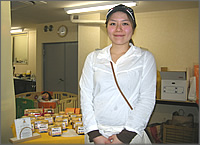
Ms. Shimamura, head Patissiere
Confiture Maison Mu uses fresh and natural ingredients to make their fruit jams. All of the fruits that they use are bought directly from farmers, and are made into jam when they are most fresh. No preservatives or colorings are added.
All jams are made by the head patissiere Ms. Shimamura alone. Ms. Shimamura graduated from a pastry school and then worked in a French pastry shop. Her turning point was when she received a large amount of organic plums from her friend, which she turned into plum jam.
At first she was simply giving away her homemade jams. It was very popular among friends, so much that the pastry shop that Ms. Shimamura worked at decided to sell them at the shop. Creatively balancing out raw and white sugar, Ms. Shimamura's famous plum jam is still one of the most popular on her menu. Ms. Shimamura became independent in 2008 and opened her shop Confiture Maison Mu in Kosuge, Tokyo.
We got to observe the step-by-step procedure of how she makes her jam.
On that particular day, she was making apple jam. She used Shinano Gold, a class of apple that has a well-balanced flavor of both sweet and tart.
She peeled off the skin, and cut the apples into bite-sized portions. Her pot filled up with apples very quickly.
QHow much jam do you make on an average day?
AGenerally, I make about s hundred bottles a day. I stick to doing only one kind of jam per day.
QIt is very impressive how much work you do by yourself.
AI have to be creative in order to do everything by myself. For example, a bag of sugar is very heavy so I put it in a custom-made crate with wheels so that it could be easily moved around.
After putting the pot on the stove, juice exuded out of apples in just a matter of minutes. The apples soften gradually. Ms. Shimamura did not take a break from stirring it during the whole process.
After boiling and stirring for about 30 minutes, sugar is added. By this time the color of the apple jam has become more defined.
QSo the sugar is added during the boiling process?
AFor apple jams, I add sugar midway through the whole process. This is because apple jams can burn easily if sugar is added in the beginning. I monitor the timing that I add sugar according to fruits.
QWhat kind of sugar do you use?
AI use granulated sugar. I use a kind that is extra fine so that it dissolves easily when heated. Occasionally I would use raw sugar from Amami Oshima.
After adding the sugar, the jam is left simmering for some more time. As Ms. Shimamura stirs the jam, we get a mouth-watering whiff of cooked apples. By this point, apples have become soft and started losing their shape. Any scum that floats to the top is removed as the jam approaches completion.
While still monitoring the contents of the pot, Ms. Shimamura pulls out her PAL.
Using a wooden spoon, a dollop of jam is placed on the PAL sample stage.
It read at 64.9% Brix.
After checking that its brix value is at the desired level, jam is bottled up. This process is done carefully but swiftly.
After sealing the lid tightly, the jam is now a finished product.
We tasted the freshly made jam on a cracker. It still had a lot of tasty apple chunks, and though it read over 60% brix, it was not overwhelmingly sweet and had a natural flavor.
Each kind of their jam has a tag line, and this one is called "spreadable apple pie."
When I tried the jam it really tasted as if I was biting into an apple pie.
QSo for this batch brix read at 64.9%. What is the general value that you aim for?
AFor apple jams I aim for over 60%. Target value changes between different kinds of jams.
QThose are pretty high readings.
AI focus on organic jams, so I don't add any synthesized preservatives. Since sugar is a natural preservative, it is important that I add enough of it.
QWhen do you take measurements?
AWhen it looks and feels done, I check with PAL. I can also measure Brix mid-process to see how much longer I need to simmer down jams. The timing that I take measurements at also changes according to each kind of fruits.
QSo for today's apple jam, you used PAL to check if the product was ready?
AYes. For jams with less water, I tend to take measurements near the end. For jams with high water content, I measure midway through the process to determine when to add sugar.
QI guess the procedure really changes from fruits to fruits.
AYes. I take into account different characteristics of each fruits and come up with the best method for each. Because I only use fruits in season, I can only process one kind of fruit once a year. Therefore, for consistency, I take good notes of procedures and Brix value for each batch.
QWhat do you like about making jam?
AIt makes me very happy when the final product reflects its naturally vivid colors of the fruits. I don't use any food coloring, so I am always very careful not to caramelize them too much. When I use raw sugar as a sweetener it sometimes reflects some of the color from the sugar, but most of the time I try to maximize the color of the fruits.
QSo I guess the key is the simmering time.
AYes it's very important. I try not to rely only on sensory evaluation but rather use a refractometer to make sure the sweetness has become satisfactory. That's how I can control and minimize simmering time.
QWhere did you learn to make jam?
AI mostly taught myself. The very first time I made jam I looked the process up on the Internet. I also take notes from famous jam makers' recopies, such as Christine Ferber's; Ms. Ferber is a world-famous patissiere who is known for her delicious jams and jellies.
QWhat are the challenges of jam making?
AIt can get overwhelming when a lot of fruits get delivered at the same time. I want to make jam when fruits are at its freshest, so I can't let it sit for too long. Because I work by myself, when I really can't get to all the fruits immediately, I do some prep work on it so it can be preserved for few days.
QWhen you say big delivery, how much exactly are you talking about?
AIt could be as much as 100kg. I can only cook about 4kg per batch in my pot, so sometimes I am up until midnight just cooking jams.
QWow, until midnight!
AYes, when it's hard like that, I try not to think about it too much and finish what I need to do, one by one!
Today we had the opportunity to watch Ms. Shimamura as she goes through her whole jam-making routine. We couldn't help but notice how she works so efficiently and gracefully.
During our visit, we had another guest observing Ms. Shimamura. Her daughter seemed to really enjoy watching her mother make jam. Ms. Shimamura had a bright smile on her face every time she talked to her daughter.
Thank you for your time.

"We are a producer of sauces and soups for wholesale, and we have been using ATAGO for over ten years."
Tamy foods produce packaged BBQ sauces, salad dressings, soup mixes, pasta sauces, etc. for restaurants.
The factory is located in Saitama prefecture about 10 minutes away from the Shin-Tokorozawa Station off of the Seibu Shinjuku Line. We arrived around 11am and were greeted by a savory aroma in the air. With stomachs growling, off we go into the production plant.
We changed into a white lab coat, hat, and mask, and we thoroughly washed and disinfected our hands before entering the production site. Ms.Ishî from the Quality and Sanitation Control department provided us with a tour of the facilities. We walked by a number of industrial size cooking pots.
A sesame-miso flavored soup mix was cooking that day. The soup is checked for not only color and taste, but also the Brix of the soup is checked with ATAGO refractometers. The entire process is carefully controlled to ensure that the quality for each batch is up to company standards.
The PAL-1, PAL-2, MASTER-SoySayce, MASTER-α, and MASTER-Sauceα are used to check the Brix of different soups, which indicates if soups are simmered down to the right consistency. We asked questions about using both the digital and analog models.
QHow are you deciding which instrument to use, PAL or MASTER, for the different applications?
AWe use the PAL for non-viscous samples, such as soy sauce, and the MASTER for thick, oily samples.
The plant workers also had questions for us.
QWhat is the best angle at which the MASTER units should be held up to the light source?
AHold the MASTER so that the tip of the instrument is facing the florescent lamp.
QWhen readings fluctuate with the PAL, should we take the average?
AIf the inconsistencies are not caused by temperature changes, then yes. Taking the average from multiple readings will provide a more concise reading of the concentration.
QWhy is it that the MASTER-α series cannot be zero-set?
AIn order to protect the water resistant feature, ATAGO designed the MASTER-α series without the scale adjustment screw. Based on feedback from our users, we are working on a new design of the MASTER-α that can be zero-set while maintaining the current water resistance feature.
QWe have samples that contain salt. Which MASTER do you recommend?
AWe recommend the model that is constructed with a resin material for the body. These is more resistant to salt than the metal body type models.
This visit was a good opportunity for us to learn about the different types of questions end-users may have when using ATAGO instruments. The experience increased our product and application knowledge to further assist other customers.
Finally, it was lunch time! Tamy Foods have an interesting system in the staff cafeteria - the food items are donated by the employees.
The lunch menu for the day included homegrown vegetables provided by the staff, such as bracken, sugar snap peas, and black rice, all of which were wonderful.
We found a tea pot in a corner of the eating area with a memo that read "Thought it's that season again." We learned that there is an employee who volunteers to provide ice-cold barley tea every summer.
We were impressed by the warm family atmosphere of the company.
We visited the Quality and Sanitation Control department in the afternoon. The department performs testing on finished products as well as calibration of the instruments used at the production site. There are many barometers to check, including measuring for Brix values. This department is the core of all quality control-related businesses in the company. ATAGO's digital refractometers, such as the PR and PAL series are used in the lab. Being the final inspection, extra care and attention go into every last detail of the process.
The lab technicians had questions for us.
QSometimes when testing with a 50% sucrose solutions the measured value is not always 50.0%. Why?
AThe higher the concentration, of the sucrose solution the more viscous it is. Some settling of the solution may occur, so it is important to stir the sample well in the container before placing it on the prism, and keep stirring the sample on the prism while taking measurements. Doing so should result in more accurate readings.
QSome sauces contain pieces of basil. Will they affect the readings?
AAs long as they are not in contact with the prism, the readings will be unaffected. Filtering the pieces of basil from the sample in advance of measuring will usually ensure more stable readings.
We asked Ms.Ishi the following question.
QWhat about your work keeps you motivated? What do you like about the company?
AI feel great responsibilities as the impact of food safety can be a matter of life or death. I like to work here because the company values the individuality of each employee. I feel that I can express my creativity. I often visit restaurants that are using our sauces to check how our products taste and also to listen to what other customers are saying about the food.
At end of our tour, we were privileged to met with the president of the company. He was kind enough to agree to be interviewed, He said, "We love your products. If I can return the favor and help you a little.." He is a warm and very generous person. We felt that the hallway decorated with soul-soothing paintings and poems as a reflection of his personality. We are delighted to have a company founded on mutual respect and care between the company and its employees as one of our good customers.
We appreciate their continued support of ATAGO products.
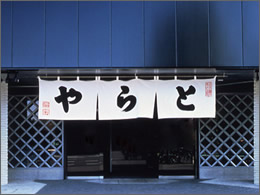
TORAYA Corporation
Known for their “yokan,” a red bean-based jellied dessert, Toraya has been a premier maker of traditional Japanese confectionery for over 480 years.
ATAGO hand-held refractometers have been used to check the sugar content of sweet bean paste called “an,” a critical ingredient for “wagashi,” traditional Japanese confections.
The manufacturing facility is surrounded by the bounty of nature and has a magnificent view of Mount Fuji. The pure and clean water from Mount Fuji is one of the quality ingredients for “wagashi.”
Mr. Tsuchiya, Production Manager, gave us a tour of the facility.
QWhat are manufacturerd at this facility?
AWe specialize in making “an,” which is the most important base ingredient for many different types of ”wagashi.” Other main products we make here include “yokan” and “monaka,” a thin crisp wafer sandwich with red bean jam filling. The plant in Tokyo uses “an” that is made here to produce other sweets.
QPlease tell us how to make ”an.”
AMaking “an” is not as simple as it sounds. There are over 40 different types.
QOver 40!?
AIt all starts with the type of “azuki” beans used. We have many different “an” recipes to make the type most suited for each confection.
First, the beans are cooked, and after the skin is removed, they are mashed into a paste. This is called “nama-an,” the base of “an.” Experienced confectioners measure the moisture level of “nama-an” and determine the desired sugar level after the beans are cooked.
Next, “nama-an” is cooked with sugar and water until it reaches a certain level of sugar content and texture.
Confectioners very much rely on their expertise to determine whether or not “an” has reached the right texture. Evaluation methods and indicators are different by “an” type, so instinctive judgment on such criteria as the feel when stirred with a large spatula called “enma,” and the texture as the mixer’s paddle is lifted are critical. We use a refractometer to check the sugar level. Not only does the moisture level of “nama-an” before cooking vary to begin with, but also each cooking tank has its quirks. Therefore, the factory supervisors set different target sugar levels for each recipe and for each tank. Our standards are adjusted and measured in an increment of 0.2% Brix.
That is true craftsmanship!
QHow many cooking tanks are there? We see a lot.
AWe have a total of 28 here. The cooking capacity per tank is anywhere from 100 to 500 liters.
QHow many tanks does one operator manage?
AAn operator is in charge of about 10 tanks at any given time. Sometimes, they move from a tank to the next every 8 minutes.
QDo you use refractometers for other purposes?
AWhen making “yokan,” we use refractometers to measure “an” and also a sweetened agar solution before they are added to the tank. Finished products are also checked with refractometers, according to the quality control standards. We literally use them throughout the production process.
Thank you very much!
QDo you have a refractometer designated for each production stage?
AThat is correct. The one the Quality Control department uses is the master unit, and all other units are calibrated to that unit at the beginning of every day.
We visited the Quality Control lab. The room was perfectly temperature-controlled. We were able to observe how a thin slice of “yokan” was measured with a hand-held refractometer (the N-2). The sugar level and texture are the main check points as their “yokan” is known for its characteristic firmness and sweetness accompanied by a pleasant aftertaste.
QHow long have you been using refractometers?
AAccording to the oldest employee at the factory, we have been using them since 1963.
ATAGO’s first hand-held refractometer was developed in 1953, which means that you have been a loyal customer of ours from the very early days.
Since then, our refractometers have gone through many model changes. We revived the once-discontinued HSR-4 by your request.
QHow are they working out for you?
AThis model is absolutely indispensable for us. The sample temperature could reach as high as 100°C, and we cannot afford waiting for it to cool down to measure. We have tried the digital model but decided that the analog type is best for us.
Thank you very much for taking the time to interview with us.
We sincerely appreciate your continued support of ATAGO refractometers.
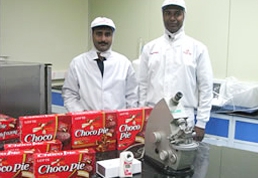
Mr. Ramkumar and Mr. Ravi Shankar
The two factories located in the cities of Chennai and Nellikuppam in the State of Tamil Nadu manufacture gums and candies.
We visited the Chennai factory that just started producing the "Choco Pie," a very popular Korean treat similar to the Oreo and Moon Pie cookies, in 2010.
The facility is very big with an extensive lawn that provides an open feel.
Mr. Ramkumar and Mr. Ravi Shankar gave us a tour. They visited Lotte of Korea many times to learn about the production. Their favorite Korean food is bibimbap.
QWhat are you measuring with the refractometers?
AWe are measuring the concentrations of glucose and sorbitol used in the "Choco Pie."
QWhich models of refractometers are you using?
AWe are using the NAR-3T, PALs, and MASTERs in the QC lab.
We are also using several hand-helds for batch testing at the production line.
ATAGO is honored to be part of Lotte's efforts to be "Asia No. 1 Confectionery Company."
A gelatin-free version of the "Choco Pie" was developed for the Indian market with a large vegetarian population. The green circle in a square indicates that the product is vegetarian-safe.
Thank you for accepting our visit at such a busy time of the year, before Diwali, and also for the "Choco Pie" souvenir. We enjoyed it!
We are looking forward to Lotte's first TV commercial in India. It is exciting news.
We appreciate your continued support of ATAGO refractometers.